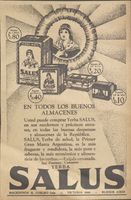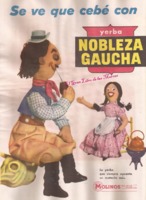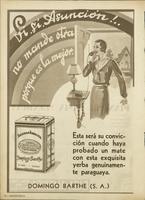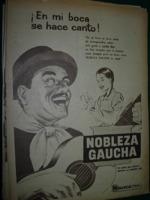Recurring Themes
This page consists of advertisements emphasizing recurring themes that I found representative around a shift in Argentinian yerba mate advertising techniques from the beginning to the end of the twentieth century.
Nationalism
While nationalism was not a common advertising theme throughout the early decades of twentieth century Argentina, it was conveyed through some Argentinian yerba mate brands. As is revealed in the Salus yerba mate advertisement, nationalism was generally used to sway the Argentinian public away from competing Paraguayan mate brands. Aside from this, nationalism was overshadowed by themes of modernity or comfort to appeal toward a middle and upper class audience. Most early twentieth century Argentinian marketers adopted foreign formulas, making national Argentinian advertising virtually nonexistent (Milanesio 71). A lack of distinctive Argentinian advertising meant that few advertisements overtly conveyed nationalistic themes in the early twentieth century.
Halfway through the twentieth century, a dramatic change occurred in Argentinian advertising. Organizations such as the Federación Argentina Publicad (Argentine Advertising Federation, 1953) and the Círculo de Redactores Publicitarios (Circle of Advertising Copywriters, 1953) emerged to promote distinct Argentine advertising (Milanesio 72). With these organizations came a key change in the site of production for Argentine advertisements: the people creating Argentine advertisements were Argentinian citizens. An important component of image analysis comes from the demographic that produces said image (Rose 27). While the demographic that produced advertisements during and after the Peronist era were generally middle and upper class males, the fact that they were Argentinian made a difference in the themes that were conveyed. Additionally, once working class Argentinians became participators in mass consumption, Argentinian advertisers shifted away from themes of modernity and toward more casual themes and conversational tones (Milanesio 71). Within this shift emerged more nationalistic and inclusive brand names like Nobleza Gaucha. The gaucho is a symbol of national identity, which became strong during the Peronist era (Milanesio). This nationalistic symbol appears continuously in advertisements for yerba mate produced in the second half of the twentieth century. The change in style is evident in this Nobleza Gaucha advertisement with less text, overt messaging, and a catchy slogan.
Gender Roles
With a shift in target audience for yerba mate advertisements came a shift in the portrayal of gender roles and expectations. Early twentieth century advertisements feature women that are well-dressed and in the center of the advertisement. The woman is generally ordering or consuming the mate, feminizing the drink and making it appeal to a female audience. This changes in the second half of the twentieth century as more traditional gender roles are reinforced. With increasing marriage rates, advertisements encouraged women to become an ideal wife by advertising goods as tools that would help them accomplish this goal (Milanesio 141). Later twentieth century mate advertisements often feature rural married couples. The woman is generally preparing the mate, rather than consuming it, conveying her ability to prepare nourishment for her husband. Both members of the couple are portrayed as happy and smiling, allowing the advertisements to sell the idea of a happy marriage along with the mate.
Representation of Race and Indigenous Peoples
The representation of indigeneity and race in yerba mate advertisements varies. In many early twentieth century mate advertisements, women were illustrated with lighter skin to appeal to higher socioeconomic sectors. This is logical as many elite Argentinians liked the white representation of Argentina (Pite 9). However, later in the century advertisers more commonly featured nonwhite characters. This video advertisement for Aguila yerba mate portrays a missionary falling in love with an indigenous woman. He is able to “civilize” her with the mate, as she puts on a white dress – connoted with purity – and takes his hand. In this case, indigenous Argentinians are displayed as uncivilized. Mate is associated with the Christian religion – structured and pure – that can make potential lower class consumers more elite or pure.




